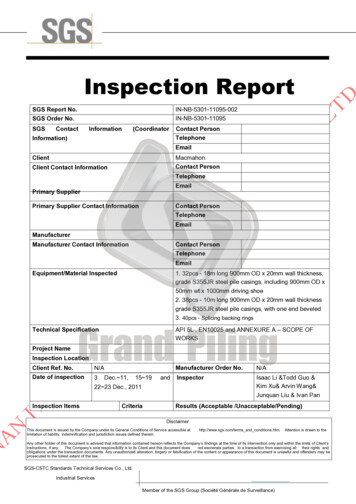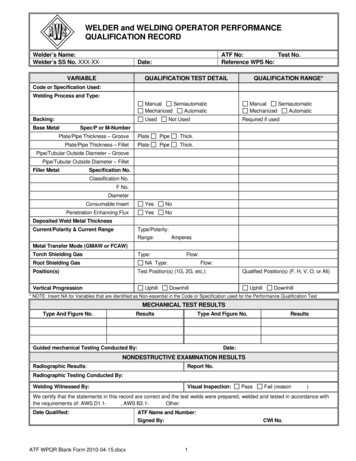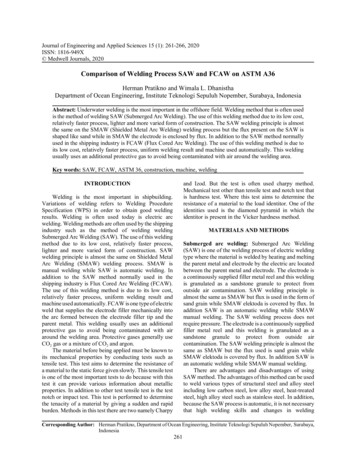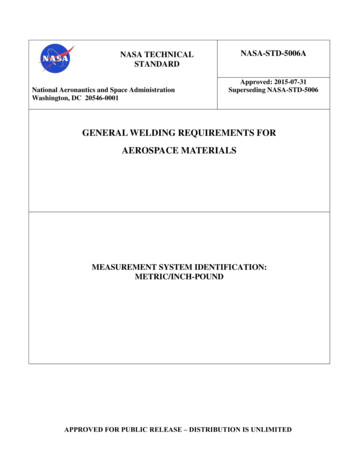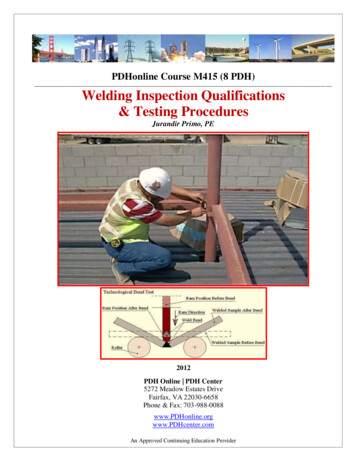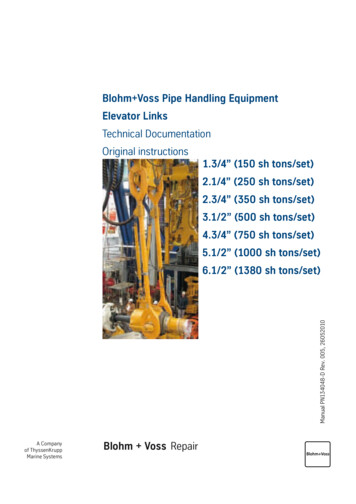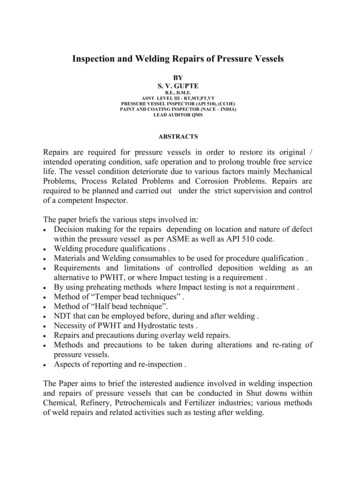
Transcription
Inspection and Welding Repairs of Pressure VesselsBYS. V. GUPTEB.E., D.M.E.ASNT LEVEL III - RT,MT,PT,VTPRESSURE VESSEL INSPECTOR (API 510), (CCOE)PAINT AND COATING INSPECTOR (NACE – INDIA)LEAD AUDITOR QMSABSTRACTSRepairs are required for pressure vessels in order to restore its original /intended operating condition, safe operation and to prolong trouble free servicelife. The vessel condition deteriorate due to various factors mainly MechanicalProblems, Process Related Problems and Corrosion Problems. Repairs arerequired to be planned and carried out under the strict supervision and controlof a competent Inspector.The paper briefs the various steps involved in: Decision making for the repairs depending on location and nature of defectwithin the pressure vessel as per ASME as well as API 510 code. Welding procedure qualifications . Materials and Welding consumables to be used for procedure qualification . Requirements and limitations of controlled deposition welding as analternative to PWHT, or where Impact testing is a requirement . By using preheating methods where Impact testing is not a requirement . Method of “Temper bead techniques” . Method of “Half bead technique”. NDT that can be employed before, during and after welding . Necessity of PWHT and Hydrostatic tests . Repairs and precautions during overlay weld repairs. Methods and precautions to be taken during alterations and re-rating ofpressure vessels. Aspects of reporting and re-inspection .The Paper aims to brief the interested audience involved in welding inspectionand repairs of pressure vessels that can be conducted in Shut downs withinChemical, Refinery, Petrochemicals and Fertilizer industries; various methodsof weld repairs and related activities such as testing after welding.
Key Words: Owner user:Owner or a user organization of the equipment. Repairer: The agency or organization, appointed by the owner user forrepairs of the equipment. Inspector: A competent inspection engineer having full knowledge ofthe pressure vessel construction, in-service inspectionwelding etc. Designer: A competent Pressure Vessel Design Engineer. Code:Code or standard used for design / construction andInspection of Pressure vessel. NDT inspector: A competent NDT inspector having thorough knowledgeand experience of NDT techniques involved in Constructionand repairs. PWHT:Post Weld Heat Treatment given to the Pressure vesselduring construction or repairs.1.0 Introduction:Repair and maintenance of parts and components is a major activity in anyprocess industry. Repair welding can be carried out as a logical procedure thatensures the part is usable and safe. If repairs are done with proper care orprecautions, it can avoid premature failures, large warranty claims, safety ofproperty and personnel and result in satisfied customers. Failures of pressurevessels are still observed, which result in a costly down time of production andproduct losses also sometimes it results in environmental hazards and unsafeworking conditions or disasters. Every owner user wants to extract highestpossible safe service life from equipment.The pressure vessel repairs also cannot be an exception this philosophy. Modernpressure vessels are constructed in accordance to a recognized code andestablished fabrication and welding practice.
2.0 Method of Inspection and decision for repairs.Pressure vessels are designed to any recognized code of design andconstruction. We must under stand that the design thickness can be considerablylower than the actual Fabricated . During design itself corrosion allowance isadded in the base metal thickness and the manufacturer fabrication chooses thenext available thickness. Thereby we have a excess thickness available for theservice which result in a considerably lower operating stress value.Steps involved in the decision making for repairs. Operating conditions, Inspection history, Material of construction ofpressure vessel . Reasons for failure . Location of the damaged area by visual inspection and evaluation byNDTs. Re-evaluate the need for repairs (Back to design calculations). Repair Methods, (For pressure retaining parts) . Preparation of repair procedures. Replacement of major components.2.1 Operating conditions, Inspection history, Material of construction ofPressure vessel:A careful study of the operating parameters and inspection history and properlymaintained internal inspection reports, materials of construction, its behaviorwith the process fluid, welding techniques used during construction, designconsideration etc, also gives an adequate confidence level about the use ofpressure vessel. Such information is also useful for making the repair decision.Carefully selected material of construction and the fabrication procedures,welding procedures as well as inspection and certification by the competentinspection authorities during fabrication stage, always intend to give suchinformation.2.2 Reasons for failures:Undesirable premature failures can occur due to any one or more of thefollowing reasons . Faulty design, faulty workmanship, wrongly selectedmaterial of construction, wrong welding techniques such premature failuresgenerally occur in an early service period, where as the normal service failuresare attributed to corrosion, changes in the working parameters, operation of thevessel for which it is not designed, impurities in the operating fluids,metallurgical changes in the base metal etc.Once the damage is identified the pressure vessels must be thoroughly inspectedto evaluate the extent of damage, need for repair and the repair method.
Thorough visual inspection of the pressure vessel can be supplemented by asuitable NDT examination, to locate the defects and the extent.2.3 Location of the damaged area by visual inspection and evaluation byNDT.On opening the equipment it is necessary to make it safe for entry as theremaining fluid or fumes of gases could be dangerous for human life. Thepersonnel may be required to stay for internal inspection there could bepossible repairs where hot work is involved, there fore a safe entry permit froma competent authority i.e from the safety and operation departments.During internal inspection, some responsible operator should always beaccessible to the inspector performing internal inspection. Such assistance canalways be handy for any critical situation.The external surface should be checked for any corrosion below the insulation,obvious leakages, structural attachments, connections, foundations, leak prooftightness of pressure relief valves etc.The internal surface should be reasonably cleaned so as to visually verify itscondition , condition of threaded connections, Flange connections, closures,internalsand damage due to corrosion. Different corrosion problems anticipatedare pitting, line corrosion., General uniform corrosion, grooving, Galvaniccorrosion, Fatigue, Creep, temperature, Hydrogen attack / Embritterment, Stresscorrosion cracking, Inter-granular corrosion, etc.The identified damage can be supplemented by NDT for the extent, where bydecision for repairs can be taken confidently, various NDT possible, are UTthickness measurement, UT scanning, RT, MPI and LPT.2.4 Re-evaluate the need for repairs (Back to design calculations)Based on the NDT results obtained, the same can be verified by the designerand inspector by performing design calculations, to ensure that the remainingthickness is still safe, and whether the repairs are warranted or not.Based on the remaining thickness corrosion rates are calculated and the MAWPat the available thickness also calculated. If the MAWP required is lower thatthe calculated MAWP then the repairs are not warranted provided the owneruser is ready to carry out internal inspection as per next scheduled interval.Location of defect is also important. On base metal away from the weld metal, amonitor thinning can be left unattended. In event there are borderline case thethickness can be recalculated by carrying our full RT and thereby revising theJoint efficiency.
Following design considerations are reviewed during re-evaluation Patch repairs welded by fillet welding can be used on temporary basis. Suchrepairs shall be checked and verified by the design Engineer. The sameshould be replaced with permanent measure at the next availablemaintenance opportunity. A fully encirclement lap joint may be consideredas a permanent repair method. Such full encirclement patches shall also bedesigned to meet the code requirements. Minimum thickness observed shall be evaluated for MAWP and thecorrosion rate, so as to decide the next inspection interval. Location of localized corrosion, such as on the base metal, away from Lseam, Away from C seam, on the weld joints, on crown portion of the head,etc. thereby, comparing the original design requirement. e.g. by carrying outL seam Radiography, the joint efficiency can be revised to 1 and theremaining thickness acceptable can be revised. The Inspector should think out all such possibilities and advise the owneruser, so as to take a precise judgment on the repair.2.5 Repair methods: (For pressure retaining parts) The cracks are gouged out or removed and weld repairs can be carried outfrom both sides, if approach is available, The deep pits or localized corrosion can be weld built to restore the originalthickness. The larger area, which cannot be welded by build up, can be replaced withpatch or a shell course or a head.So far SMAW or GTAW has been the most widely accepted welding processesin the industry, for its availability of welding equipment and skilled welders.However FCAW or GMAW processes can also be used if sufficient expertiseand equipment are available.Need less to state that any code requirements, contractual requirements or anystatutory / regulatory requirement must be complied during weld repairs.Original construction drawing, calculation data and inspection records areimportant for repairs. If the original construction data is not accessible, then ananalysis of the base material, including previous weld deposits, becomesmandatory. If dimensions require close tolerances or if flatness is critical, thenbenchmarks that will aid the repair without causing excessive and expensivedamage to the work piece must be established.The crack in weld joint or a defect in the base metal can be repaired bypreparing a “U” or a “V” groove to the full depth and length of crack and thenfill up by weld metal deposit as described here. If the crack exists in the stress
concentration region then consult a competent pressure vessel design Engineer.Corroded area may be restored by weld metal deposition as described here.2.6 Preparation of a repair procedure:The repair procedure should take care of the requirements of the base metal,welding consumables, sequential weld deposits, requirements of preheat,Interpass temperature, post weld heating, PWHT, impact test and the NDTrequirements.The repair procedure shall be qualified as per the recognized code such asASME sec IX, using an experienced welder. Maintain the records of procedurequalification as well as performance qualification.If PWHT is required in original construction and it is not practicable oradvisable during repairs, then the Inspector and the Pressure Vessel DesignEngineer shall review the reason for original PWHT of the equipment. If theOriginal reason why PWHT was done is due to the service requirements, thenthe alternative methods given below may be avoided, Details of RepairProcedures and consideration are given in 3.0 of this article. It is allowed by theRepair & Inspection code to avoid the PWHT as well as Pressure test afterrepairs.3.03.1 3.2Considerations for repair Procedures: [1 , 2]Repair procedure alternative to PWHT, Pre heating method, whereimpact testing is not done on the original equipment.Impact testing is not required when this welding method is used.This procedure is limited to P1-Gr. 1 & 2; P3 –Gr. 1 & 2 (Excluding Mn-Mosteels)The weld area is pre heated and maintained at a minimum 150 deg C, duringwelding. The temperature is measured to ensure 4” material or 4 timesthickness ( whichever is greater) from the each edge of weld is maintainedduring welding.The maximum Interpass temperature does not exceed 315 deg CCarry out welding as per the qualified procedure.Repair procedure alternative to PWHT, where impact testing isperformed on the original equipment.When the original construction required impact test, Notch toughness testing asrequired by the code of construction is required. A procedure need to bequalified separately by using a groove welding on the plate Some additionalrequirements that can be considered over and above the supplementary essentialvariable are:
This procedure is limited to P1; P3 and P4 steels. All supplementary essential elements of ASME Section IX para QW-250 areapplied. The weld area is pre heated and maintained at a minimum 150 deg C, duringwelding. The temperature is measured to ensure 4” material or 4 timesthickness (whichever is greater) from the each edge of weld is maintainedduring welding. The maximum Interpass temperature does not exceed 315 deg C . Maximum heat input shall be calculated and implemented during repairs.The maximum heat inputs as per qualified procedure must not exceed duringwelding. Qualification thickness for the plate material and the grooves are as per thetable 1. If the welding is to be done under NACE standard, MR 0175, then additionaltest for hardness measure to be applied. For SMAW welding process, electrodes with additional supplementaldiffusible hydrogen designator H8 or lower shall be used. The gas used inGTAW or GMAW or FCAW shall exhibit a dew point no higher than minus50 deg C. Welding shall be carried out as per controlled deposition, temper bead orHalf bead technique. After completion of welding, without allowing to reduce the preheat, thetemperature is raised to 230 to 280 Deg C. and held for minimum period ofabout 2 Hrs to assist as Hydrogen bake out treatment. The Hydrogen bake out treatment can be omitted if electrodes havingsupplemental diffusible hydrogen designator H4 are used. After cooling the weld metal, the excess layer of reinforcement is ground offto match the surface contour of base metal.3.3 Non-Destructive Examination and testing of repaired location. The prepared surface can be checked by using MPI or LPT before welding. After completion of welding, NDE acceptable to the Authorized Inspectoror the owner user are selected and applied to ensure soundness of the weld. After repairs the need for pressure test is to be decided by the Inspector. Thetest temperature and the minimum design metal temperature of Pressurevessel shall be carefully evaluated. If Hydrostatic test is impracticable, then pneumatic test should be consideredwith appropriate safety consideration.
3.4 Repair to Stainless steel overlays and clad. In event any overlay or cladding area is removed, then the base metal getsexposed to the service environment. The Inspector should give consideration to remove the possible entrappedhydrogen if the service and the base metal is prone to hydrogen entrapment,hydrogen embrittlement, Temper embrittlement etc. A heating treatmentsuch as Hydrogen bake out at 230 to 280Deg C, for about 2 Hrs. shall begiven.4.0 Execution of welding repairs: The repairer, under close supervision and surveillance of the Inspector,executes actual repairs. The written and qualified procedures are strictlyfollowed. In case the Impact testing is specified, the welding parameters arealso monitored and ensured to be within the range at which the procedure isqualified. Specified NDE before welding repairs and after welding repairs are carriedout and shall be approved by the Inspector. After repairs the inspection record and the history of equipment, givingdetails of repairs, is updated and next inspection schedule shall berecommended to the owner user.5.0Welding techniques: [1, 2]5.1 Temper bead welding technique:The heat affected zone of the bottom bead due to the top bead applied withlower size electrode, leaves less than 20 to 30 % of the weld metal crosssectional area as a “ typical columnar grains” and the balance is a normalizedstructure.The top layer of the reinforcement mainly consisting of columnar grains, isrequired to be ground out, to match the surface contour.5.2 Half bead welding technique,After every pass, the top half of the weld bead is ground off before applying thenext layer.Such half bead technique also achievs the similar effect of temper beadtechnique, but then the consumption of welding electrodes can shoot up.
6.0 Conclusion:I wish to draw the following conclusions: Repairs of pressure vessels are not always warranted, the decision of weldingrepairs must be taken with due consideration to the location of defect,carefully evaluated and interpreted NDE results, Design Calculations,Construction condition such as PWHT and Impact test. Once the decision of welding repairs is taken then it is necessary todocument the repair procedure giving details of NDT test necessary, Per heatand PWHT, welding sequence, monitoring the welding parameters, pressuretest requirements etc. Prepare the inspection reports and follow up inspection at a predefinedinspection interval.7.0 References: API 510 - Pressure vessel inspection code. ANSI NB 23 – National Board Inspection code.Table 1: Qualification thicknesses for test coupon and test repair groove.Depth ofTest GroovetRepair grooveDepthThickness ofTest CouponThickness ofBase t 2”Up to 2”t t 2”Above 2”Santosh Gupte can be contacted at guptesantosh@hotmail.com
established fabrication and welding practice. 2.0 Method of Inspection and decision for repairs. Pressure vessels are designed to any recognized code of design and construction. We must under stand that the design thickness can be considerably lower than the actual


